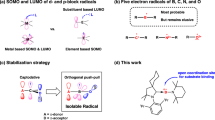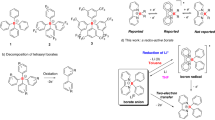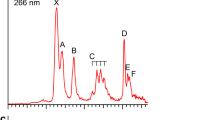Abstract
Two-coordinate boron cations (R2B+), referred to as borinium ions, are chemical species in which the boron bears only four valence electrons, and that are isoelectronic with hypothetical carbon dications (R2C2+). Although lone-pair-donating substituents such as amino groups have enabled the isolation of several borinium ions, diarylated and dialkylated borinium derivatives remain entirely unexplored. Here, we present the synthesis, structure and reactivity of the dimesitylborinium ion, which displays unexpectedly high thermal stability. X-ray crystallography and 11B NMR spectroscopy, supported by density functional theory calculations, reveal that the borinium ion adopts a linear two-coordinate structure in both the solid state and in solution. The boron centre is stabilized by pπ bonding from the mesityl groups and is free from coordination by the counterion or solvent molecules. This diarylborinium ion possesses exceptional Lewis acidity, accepting a pair of electrons from CO2 to cause an unusual deoxygenation reaction.
This is a preview of subscription content, access via your institution
Access options
Subscribe to this journal
Receive 12 print issues and online access
$259.00 per year
only $21.58 per issue
Buy this article
- Purchase on Springer Link
- Instant access to full article PDF
Prices may be subject to local taxes which are calculated during checkout



Similar content being viewed by others
References
Suzuki, A. Cross-coupling reactions of organoboranes: an easy way to construct C–C bonds (Nobel Lecture). Angew. Chem. Int. Ed. 50, 6723–6737 (2011).
Brown, H. C. Hydroboration (W. A. Benjamin, 1962).
Shinkai, S. & Takeuchi, M. Molecular design of synthetic receptors with dynamic, imprinting, and allosteric functions. Bull. Chem. Soc. Jpn 78, 40–51 (2005).
Mastalerz, M. The next generation of shape-persistent zeolite analogues: covalent organic frameworks. Angew. Chem. Int. Ed. 47, 445–447 (2008).
Wade, C. R., Broomsgrove, A. E. J., Aldridge, S. & Gabbaï, F. P. Fluoride ion complexation and sensing using organoboron compounds. Chem. Rev. 110, 3958–3984 (2010).
Lipscomb, W. N. Boron Hydrides (W. A. Benjamin, 1963).
Moezzi, A., Olmstead, M. M. & Power, P. P. Boron–boron double bonding in the species [B2R4]2: synthesis and structure of [{(Et2O)Li}2{Mes2BB(Mes)Ph}], a diborane(4) dianion analog of a substituted ethylene. J. Am. Chem. Soc. 114, 2715–2717 (1992).
Segawa, S., Yamashita, M. & Nozaki, K. Boryllithium: isolation, characterization, and reactivity as a boryl anion. Science 314, 113–115 (2006).
Wang, Y. et al. A stable neutral diborene containing a BB double bond. J. Am. Chem. Soc. 129, 12412–12413 (2007).
Shoji, Y. et al. A stable doubly hydrogen-bridged butterfly-shaped diborane(4) compound. J. Am. Chem. Soc. 132, 8258–8260 (2010).
Kinjo, R., Donnadieu, B., Celik, M. A., Frenking, G. & Bertrand, G. Synthesis and characterization of a neutral tricoordinate organoboron isoelectronic with amines. Science 333, 610–613 (2011).
Braunschweig, H. et al. Ambient-temperature isolation of a compound with a boron–boron triple bond. Science 336, 1420–1422 (2012).
Hübner, A. et al. Confirmation of an early postulate: B–C–B two-electron–three-center bonding in organo(hydro)boranes. Angew. Chem. Int. Ed. 51, 12514–12518 (2012).
Braunschweig, H., Damme, A., Dewhurst, R. D. & Vargas, A. Bond-strengthening π backdonation in a transition-metal π-diborene complex. Nature Chem. 5, 115–121 (2013).
Kölle, P. & Nöth, H. The chemistry of borinium and borenium ions. Chem. Rev. 85, 399–418 (1985).
Piers, W. E., Bourke, S. C. & Conroy, K. D. Borinium, borenium, and boronium ions: synthesis, reactivity, and applications. Angew. Chem. Int. Ed. 44, 5016–5036 (2005).
Chiu, C-W. & Gabbaï, F. P. Diarylborenium cations: synthesis, structure, and electrochemistry. Organometallics 27, 1657–1659 (2008).
Matsumoto, T. & Gabbaï, F. P. A borenium cation stabilized by an N-heterocyclic carbene ligand. Organometallics 28, 4252–4253 (2009).
Osberghaus, O. Die isotopenhäiufigkeit des bors. Massenspektrometrische untersuchung der elektronenstoßprodukte von BF3 und BCI3 . Z. Phys. 128, 366–377 (1950).
Law, R. W. & Margrave, J. L. Mass spectrometer appearance potentials for positive ion fragments from BF3, B(CH3)3, B(C2H5)3, B(OCH3)3, and HB(OCH3)2 . J. Chem. Phys. 25, 1086–1087 (1956).
Davidson, J. M. & French, C. M. The existence of an organic cation containing boron. J. Chem. Soc. 114–117 (1958).
Moodie, R. B. Ellul, B. & Connor, T. M. Evidence for the structure of boronium ions from proton magnetic resonance and conductivity measurements. Chem. Ind. 767–768 (1966).
Uddin, M. K., Fujiyama, R., Kiyooka, S., Fujio, M. & Tsuno, Y. Preparation and characterization of diphenylboron cation in solution. Tetrahedron Lett. 45, 3913–3916 (2004).
Nöth, H., Staudigl, R. & Wagner, H-U. Contributions to the chemistry of boron. 121. Dicoordinate amidoboron cations. Inorg. Chem. 21, 706–716 (1982).
Higashi, J., Eastman, A. D. & Parry, R. W. Synthesis and characterization of salts of the bis(diisopropylamido)boron(III) cation and attempted reactions to make the corresponding bis(dimethylamido)boron(III) cation. Inorg. Chem. 21, 716–720 (1982).
Courtenay, S., Mutus, J. Y., Schurko, R. W. & Stephan, D. W. The extended borinium cation: [(tBu3PN)2B]+. Angew. Chem. Int. Ed. 41, 498–501 (2002).
Reed, C. A. H+, CH3+, and R3Si+ carborane reagents: when triflates fail. Acc. Chem. Res. 43, 121–128 (2010).
Körbe, S., Schreiber, P. J. & Michl, J. Chemistry of the carba-closo-dodecaborate(–) anion, CB11H12−. Chem. Rev. 106, 5208–5249 (2006).
Kim, K-C. et al. Crystallographic evidence for a free silylium ion. Science 297, 825–827 (2002).
Mantina, M., Chamberlin, A. C., Valero, R., Cramer, C. J. & Truhlar, D. G. Consistent van der Waals radii for the whole main group. J. Phys. Chem. A 113, 5806–5812 (2009).
Olmstead, M. M., Power, P. P., Weese, K. J. & Doedens, R. J. Isolation and X-ray crystal structure of the boron methylidenide ion [Mes2BCH2]− (Mes=2,4,6-Me3C6H2): a boron–carbon double bonded alkene analog. J. Am. Chem. Soc. 109, 2541–2542 (1987).
Lambert, J. B., Zhang, S., Stern, C. L. & Huffman, J. C. Crystal structure of a silyl cation with no coordination to anion and distant coordination to solvent. Science 260, 1917–1918 (1993).
Davlieva, M. G., Lindeman, S. V., Neretin, I. S. & Kochi, J. K. Structural effects of carbon monoxide coordination to carbon centres. π and σ bindings in aliphatic acyl versus aromatic aroyl cations. New J. Chem. 28, 1568–1574 (2004).
Pachaly, B. & West, R. Synthesis of a 1,3-dioxa-2,4-diboretane, an oxoborane precursor. J. Am. Chem. Soc. 107, 2987–2988 (1985).
De Vries, T. S., Prokofjevs, A. & Vedejs, E. Cationic tricoordinate boron intermediates: borenium chemistry from the organic perspective. Chem. Rev. 112, 4246–4282 (2012).
Braunschweig, H. et al. Controlled homocatenation of boron on a transition metal. Nature Chem. 5, 563–567 (2013).
Braunschweig, H. et al. Metal-free binding and coupling of carbon monoxide at a boron–boron triple bond. Nature Chem. 5, 1025–1028 (2013).
Litters, S., Kaifer, E., Enders, M. & Himmel, H-J. A boron–boron coupling reaction between two ethyl cation analogues. Nature Chem. 5, 1029–1034 (2013).
Eisch, J. J., Shafii, B., Odom, J. D. & Rheingold, A. L. Aromatic stabilization of the triarylborirene ring system by tricoordinate boron and facile ring opening with tetracoordinate boron. J. Am. Chem. Soc. 112, 1847–1853 (1990).
Acknowledgements
This work was supported by KAKENHI (22750046). The authors thank C.A. Reed for his instruction regarding carboranes synthesis and valuable discussions. RIKEN Integrated Cluster of Clusters (RICC) provided the computer resources for the DFT calculations.
Author information
Authors and Affiliations
Contributions
Y.S. and T.F. conceived and designed the work. Y.S. and N.T. performed the experiments. Y.S., N.T. and T.F. analysed the experimental data. K.M. and M.U. performed the DFT calculations and analysed the computational data. Y.S., M.U. and T.F. co-wrote the paper.
Corresponding author
Ethics declarations
Competing interests
The authors declare no competing financial interests.
Supplementary information
Supplementary information
Supplementary information (PDF 8874 kb)
Supplementary information
Crystallographic data for compound 1a (CIF 57 kb)
Supplementary information
Crystallographic data for compound 1b (CIF 18 kb)
Supplementary information
rystallographic data for compound 2a (CIF 49 kb)
Rights and permissions
About this article
Cite this article
Shoji, Y., Tanaka, N., Mikami, K. et al. A two-coordinate boron cation featuring C–B+–C bonding. Nature Chem 6, 498–503 (2014). https://doi.org/10.1038/nchem.1948
Received:
Accepted:
Published:
Issue Date:
DOI: https://doi.org/10.1038/nchem.1948
This article is cited by
-
A crystalline doubly oxidized carbene
Nature (2023)
-
A linear Di-coordinate boron radical cation
Nature Communications (2022)
-
Formation of environmentally stable hole-doped graphene films with instantaneous and high-density carrier doping via a boron-based oxidant
npj 2D Materials and Applications (2019)
-
Boron-mediated sequential alkyne insertion and C–C coupling reactions affording extended π-conjugated molecules
Nature Communications (2016)
-
Boron served straight up
Nature Chemistry (2014)




